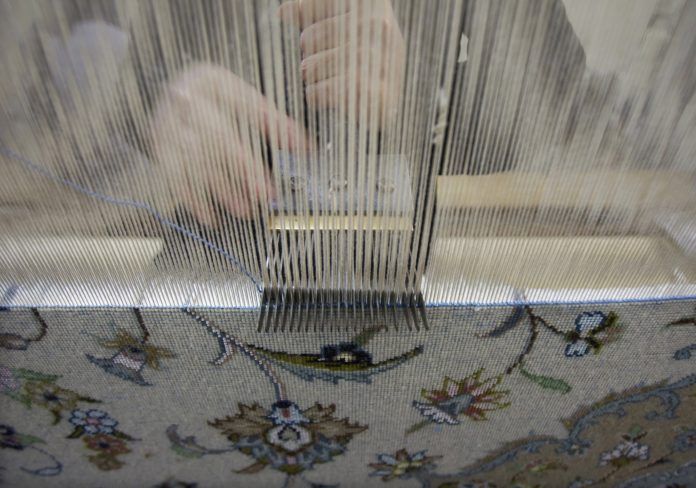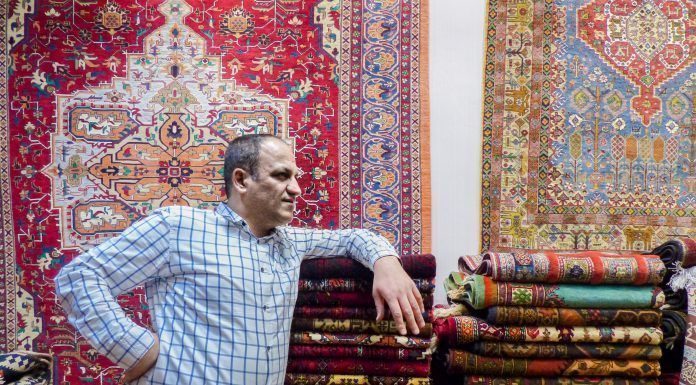
By Kayhan Life Staff
Data shows that Iran’s share of the international handmade rug market share dropped to only 9 percent in 2019. While the export of Persian carpets has been shrinking steadily in recent years, India, Iran’s principal rival in the carpet industry, has increased its international market share from 14 percent in 2000 to 35 percent in recent years.
While state officials continue to blame economic sanctions for the significant drop in the export of handmade rugs, industry insiders and market analysts cite the lack of government support for the carpet industry as the primary reason for the downward trend.
A recent report by the Islamic Republic of Iran Customs Administration (IRICA) showed the country’s export of handmade rugs dropped from $690 million in value and 26,000 tons in weight to $72 million and 4,000 tons. The data showed a massive decrease in the export volume of handmade rugs — from 26,300 tons in 1999 to a mere 3,000 tons in 2019, 3,900 tons in 2020, and 1,200 tons from late March to early November of this year.
The total for Iran’s non-oil exports was $3.941 billion in 1999, 17.5 percent of which was from the sale of handmade carpets. The country’s share of the international handmade rug market was 32 percent in 2000. Iran has been the biggest loser in a declining global handmade carpet. Turkey, China, Pakistan, and India have filled the vacuum left by the almost non-existence Iranian rug exports.
The top 10 importers of Iranian handmade carpets in 2018 were the U.S., Germany, the United Arab Emirates (UAE), Japan, Lebanon, Australia, Canada, Qatar, Italy, and Pakistan. The top 10 importers of Iranian rugs in 2019 were Japan, Germany, the UAE, Lebanon, South Africa, Qatar, Italy, Australia, Britain, and India.
Iran’s rug exports to its main customers have also dropped significantly in recent years. For instance, the country exported $24 million and $36 million worth of handmade rugs to Japan and Germany in 2018, and that amount dropped to $13.2 million and $12.9 million the following year. Iran exported less than $1 million in handmade rugs to 16 countries last year.
During a workgroup meeting for developing Iran’s non-oil export in 2020, Hamid Zadboom, Deputy Minister of Industry, Mines and Trade and the director of the Trade Promotion Organization of Iran (TPOI), said the government was focusing on developing the handmade rug industry. However, it is unclear what the government has achieved in that respect since then.
Iranian officials blame the problems facing the country’s handmade carpet industry on the U.S. and former President Donald Trump, who reimposed stringent economic sanctions after withdrawing from the 2015 Joint Comprehensive Plan of Action (JCPOA), better known as the Iran nuclear deal, in 2018.
However, trade experts argue that the difficulties with exporting Iranian handmade rugs started long before the reimposition of sanctions. They cite the lack of government support for the industry as the principal reason for the sharp drop in export volume.
Industry experts note that Iranian handmade rugs are significantly more expensive than those produced by other countries, making them less competitive on the international market. The high cost of raw materials, mostly imported, and cheap labor in other countries are the main reasons Iran cannot compete in the global handmade rug market. While the high rate of foreign exchange pushes up raw materials prices, inflation increases the cost of labor. However, the workforce remains the most economically disadvantaged segment of Iranian society.
Experts believe it costs $470 in capital investment to create a job in handmade rug manufacturing, which is considerably less than in other industries.
In comments reported by the media in September, Ali Alahmad, a member of the board of directors of Iran Carpet Manufacturers and Exporters Association, said the high rate of foreign exchange and not using the rial for the sale of rugs had slowed the domestic trade and export of the handmade carpets significantly.
Around the same time, Seyyed Razi Haji-Aghmiri, the former director of the Iran Export Confederation, said that Turkey had banned the import of Iranian handmade rugs, adding that “many people fear that export revenue will not return to the country because of our strained foreign relations with other countries.”
According to several industry observers, many carpet designers and artisans have left Iran to find work in other countries. A carpet designer or weaver reportedly earns $3,000 a month in Turkey.
“Many Turkish manufacturers have bought machinery for weaving 1,500 reed fine carpets,” Ali Farhi, an Iranian carpet manufacturer, said. “However, they do not have the expertise to manufacture such carpets, and that is why they hire Iranian designers.”
Saeed Monzavizadeh, a manufacturer and exporter of handmade carpets, also argued: “Unfortunately, the brain drain and emigration of experts to other countries include carpet designers, because international industries pay higher salaries and wages to craftspeople.”
Gholamhossein Shafiei, the director of Iran Chamber of Commerce, Industries, Mines and Agriculture, had previously said: “Unfortunately, in the past 30 or 40 years, many of our carpet weavers and designers have left Iran for other countries including Pakistan and China, taking the industry with them. We cannot compete in the global market, given that it cost significantly less to manufacture handmade carpets in China and Pakistan than in Iran.”








